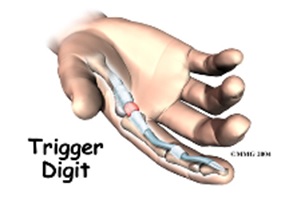
Trigger finger and trigger thumb are conditions affecting the movement of the tendons as they bend the fingers or thumb toward the palm of the hand. This movement is called flexion.
Anatomy
Where does the condition develop?
The tendons that move the fingers are held in place on the bones by a series of ligaments called pulleys. These ligaments form an arch on the surface of the bone that creates a sort of tunnel for the tendon to run in along the bone. To keep the tendons moving smoothly under the ligaments, the tendons are wrapped in a slippery coating called tenosynovium.
The tenosynovium reduces the friction and allows the flexor tendons to glide through the tunnel formed by the pulleys as the hand is used to grasp objects.

Causes
Why do I have this problem?
Triggering is usually the result of a thickening in the tendon that forms a nodule, or knob. The pulley ligament may thicken as well.
The constant irritation from the tendon repeatedly sliding through the pulley causes the tendon to swell in this area and create the nodule. Rheumatoid arthritis, partial tendon lacerations, repeated trauma from pistol- gripped power tools, or long hours grasping a steering wheel can cause triggering. Infection or damage to the synovium causes a rounded swelling (nodule) to form in the tendon. Triggering can also be caused by a congenital defect that forms a nodule in the tendon. The condition is not usually noticeable until infants begin to use their hands.
Symptoms
What does a trigger finger or thumb feel like?
-
- Painand a funny
clicking sensation when the finger or thumb is bent. Pain usually occurs when the finger or thumb is bent and straightened.
- Painand a funny

- Tendernessusually occurs over the area of the nodule, at the bottom of the finger or thumb. The clicking sensation occurs when the nodule moves through the tunnel formed by the pulley ligaments. With the finger straight, the nodule is at the far edge of the surrounding ligament. When the finger is flexed, the nodule passes under the ligament and causes the clicking sensation.
- If the nodule becomes too large it may pass under the ligament, but it gets stuck at the near edge. The nodule cannot move back through the tunnel, and the finger is locked in the flexed trigger position.

Diagnosis
How do doctors identify the condition?
The diagnosis of trigger finger and thumb is usually quite obvious on physical examination. Usually a palpable click can be felt as the nodule snaps under the first finger pulley. If the condition is allowed to progress, the nodule may swell to the point where it gets caught and the finger is locked in a bent, or flexed, position. Diagnostic ultrasound may also be required to further evaluate.
Treatment
What can be done for the condition?
- Ultrasound, soft tissue and stretchesto soften the thickened nodule
- Iontophoresis,
which uses a mild electrical current to push anti-inflammatory medicine to the sore area. - Dry needlingto encourage healing.
- Special exercisesare used to encourage normal gliding of the tendon. You might be shown ways to change your activities to prevent triggering and to give the inflamed area a chance to heal. This treatment is especially helpful for patients who can’t tolerate injections.
- A cortisone injection into the tendon sheath may be needed to decrease the inflammation and shrink the nodule. This can help relieve the triggering, but the results may be short lived. A splint may be used after the injection to rest the tendon and help decrease the inflammation and shrink the nodule.

